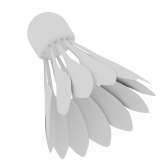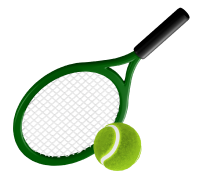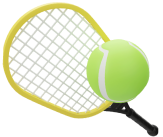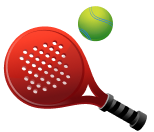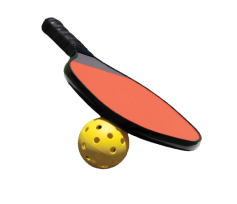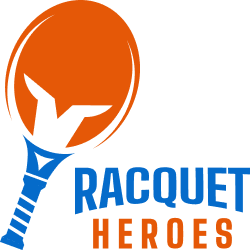Pickle Ball
Know all the basic Pickle rules and regulations, how to play the game,
court lines, how to score points and more!
1. the game

Pickleball is a paddle sport played with a perforated ball on a 20-feet by 44-feet court with a tennis-type net. The court is divided into right/even and left/odd service courts, as well as non-volley zones.
The ball is served diagonally across the net to the opponent’s receiving court using an approved motion. The ball is struck back and forth across the net until a player fails to return the ball in accordance with the rules.
Points are scored only by the serving side when the server or the server’s team wins the rally, or the opposing side commits a fault. The server continues to serve, alternating service courts, until the serving side loses the rally or commits a fault.
Typically, the first side to score 11, 15, or 21 points, with at least a 2-point lead, wins.
Pickleball can be played as singles or doubles.
1.1 The Players
Pickleball is a game that requires cooperation and courtesy. A sense of fair play,from giving the opponent the benefit of any doubt is essential in maintaining the game’s underlying principles of fun and competition. To that end:
- All points played are treated the same regardless of their importance; the first point of the match is as important as match point.
- Either partner in doubles can make calls, especially line calls; there is no place in the game The ball is served diagfor one partner telling another, “That was my call, not yours.”
- Prompt calls eliminate the ‘two chance option.’ For example, a player cannot claim a hinder from a ball rolling on the court after they hit a ball ‘out;’ they gave up their ability to call the hinder by choosing instead to hit the ball.
- Players strive to cooperate when confronted with a situation not covered by the Rulebook. Possible outcomes can be a replay, allowing the rally to stand, or in extreme cases, asking for a referee to resolve a dispute.
- Where possible, rules accommodate players with various adaptive needs.
- Players avoid wearing clothing that closely matches the ball color.
- Players should not question or comment on an opponent’s call, although any player may appeal a rally-ending line call to the referee before the next serve occurs.
1.2 Unique Features
- Two-Bounce Rule: After the ball is served, each side must make one groundstroke prior to volleying the ball. Non-Volley Zone (NVZ).
- An area that extends 7 feet from the net on each side, where a player is not allowed to strike the ball without it first bouncing.
- More specifically, the whole court from net to baseline is the same and can be freely used for all play with one exception: volleying.
- The second bounce can be anywhere on the playing surface, which includes the area surrounding the court.
2. the court
2.1 Court Specifications
-
The pickleball court measures 20 feet (6.10 m) wide by 44 feet (13.41 m) long for both singles and doubles matches. Lines should be 2 inches wide and contrast with the playing surface.
-
The minimum playing surface is 30 feet wide by 60 feet long, with a 10-foot surrounding margin. Recommended dimensions are 40 feet by 64 feet.
- The recommended playing surface for wheelchair play is 44 feet wide by 74 feet long. For stadium courts, it is 50 feet wide by 80 feet long.
2.2 Lines and Areas
-
Baselines : Lines parallel to the net at each end of the court.
-
Sidelines : Lines perpendicular to the net on each side of the court.
-
Non-Volley Zone (NVZ) : The area on each side of the net, bounded by a line parallel to and 7 feet (2.13 m) from the net. All NVZ lines are part of the NVZ.
-
Service Court : The area beyond the NVZ on each side of the centerline, including the centerline, sideline, and baseline.
-
Centerline : The line down the center of the court on each side of the net, extending from the NVZ to the baseline, separating the odd and even service courts. For Mini-singles, it also extends through the NVZ.
-
Right/Even Court : The service area on the right side of the court when facing the net.
-
Left/Odd Court : The service area on the left side of the court when facing the net.
2.3 Net Specifications
-
Material: The net must be made of mesh fabric that prevents the ball from passing through.
-
Posts : Net posts should be 22 feet (6.71 m) apart, with a maximum diameter of 3 inches (7.62 cm).
-
Size : The net should be at least 21 feet 9 inches (6.63 m) long and 30 inches high at the edges.
-
Edge : The top of the net must be edged with 2-inch (5.08-cm) white tape binding over a cord or cable.
-
Center Strap and Height : A center strap is recommended to adjust the net height to 34 inches (86.36 cm) at the center, with the height at the sidelines being 36 inches (91.44 cm).
-
Draping Net : If the ball hits a draping net on the ground (except on serve), a replay is required.

3. Equipments
3.1 Ball Specifications
-
Design : The ball must have 26 to 40 circular holes and include the manufacturer’s or supplier’s name or logo.
-
Approval : The Tournament Director selects the tournament ball, which must be listed on the official approved balls list at USApickleball.org.
-
Construction : The ball should be made of durable material with a smooth,uniform-colored surface, free of texturing. A slight ridge at the seam is acceptable if it doesn’t affect flight.
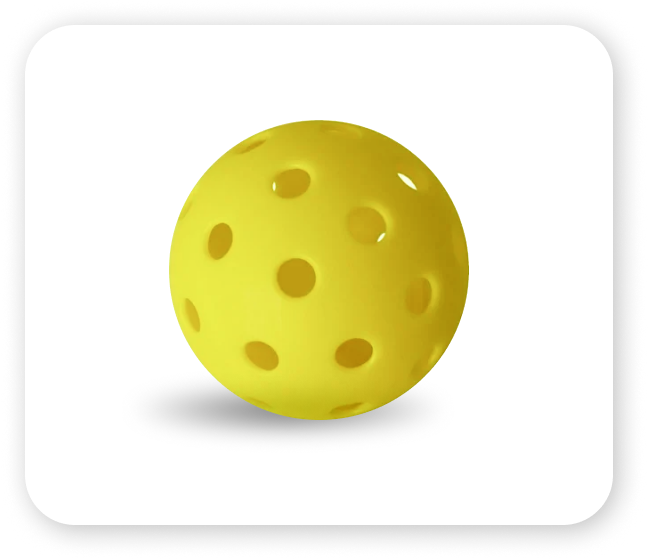
3.2 Paddle Specifications
-
Material : The paddle must be made from safe, rigid, non-compressible materials as specified on the USA PICKLEBALL website.
-
Surface : The hitting surface must be smooth, without delamination, holes, cracks, rough textures, or features that could impart excessive spin. It must not be reflective enough to affect the opponent’s vision.
-
Size : The total length and width, including any edge guard and butt cap, must not exceed 24 inches (60.96 cm). Paddle length cannot exceed 17 inches (43.18 cm). Thickness is unrestricted.
-
Weight : There are no restrictions on paddle weight.
-
Model Designation : The paddle must have a manufacturer-provided brand and model name or number clearly marked, either as a decal or other affixed label.
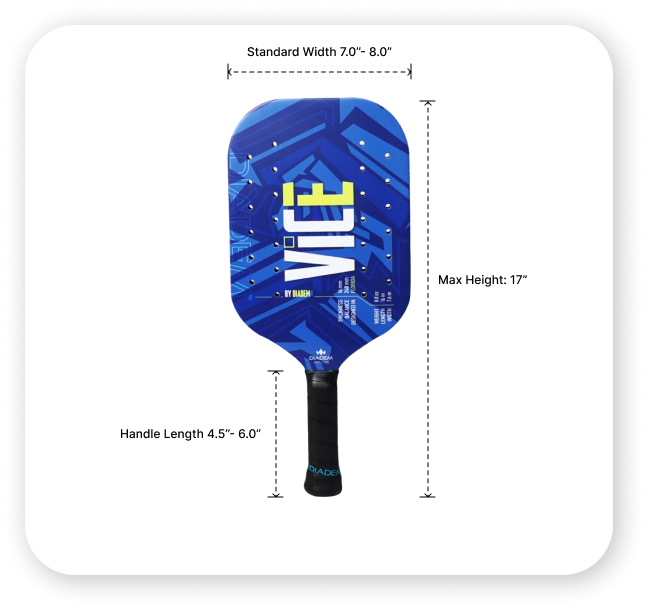
3.2.6 Alterations
-
Permitted alterations include edge guard tape, weighted tape, grip modifications, and identification markings.
-
Decals and tape must not extend more than 1 inch (2.54 cm) above the grip or 0.5 inch (1.27 cm) inside the paddle edge or edge guard.
-
Handwritten markings are allowed for identification only; aftermarket graphics are not.
3.2.7 Prohibited Features
-
Anti-skid paint or textured surfaces that add spin.
-
Rubber or synthetic rubber.
-
Moving parts that increase momentum.
4. Apparel
-
Safety and Distraction: Apparel that is inappropriate or similar in color to the ball may need to be changed.
-
Depictions: Graphics and text on apparel must be in good taste.
-
Footwear: Shoes must not mark or damage the court.
-
Violation: The Tournament Director may enforce apparel changes with a non-chargeable time-out. Refusal to comply may result in a match forfeit.
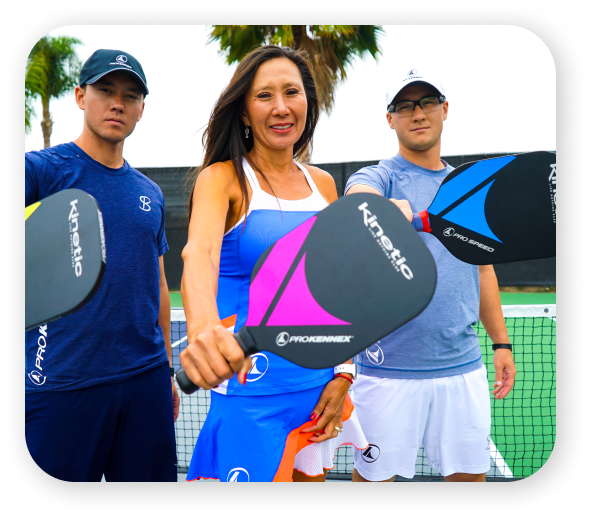
5. Defination
-
Ball In Play : Apparel that is inappropriate or similar in color to the ball may need to be changed
-
Carry : Apparel that is inappropriate or similar in color to the ball may need to be changed
-
Dead Ball : Apparel that is inappropriate or similar in color to the ball may need to be changed
-
Double Bounce : When the ball bounces twice on one side before being returned.
-
Double Hit : Hitting the ball twice before it is returned.
-
Fault : A rule violation that results in a dead ball and/or ends the rally.
-
Groundstroke : A strike of the ball after it has bounced.
-
Live Ball : The time when the referee or server starts to call the score. (See also “Ball In Play.”)
-
Non-Volley Zone (NVZ) : A 7-foot-by-20-foot area adjacent to the net. All lines bounding the NVZ are part of it.
-
Rally : Continuous play after the serve and before a fault.
-
Replay : A rally restarted without awarding a point or changing the server.
-
Serve : The initial strike of the ball to start a rally.
-
Server : The player who initiates the rally.
-
Service Court : The area on either side of the centerline, including the centerline, sideline, and baseline, excluding the NVZ.
-
Side Out : The awarding of the serve to the opposing team after a loss of serve.
-
Volley : A strike of the ball out of the air before it has bounced.
6. serving
6.1 Calling the Score :
The full score must be called out before serving
6.2 Serve Placement :
The serve must go to the correct service court (diagonally opposite) and clear the non-volley zone (NVZ). The ball can land on any service court line except the NVZ lines.
6.3 Net Contact :
If the serve clears the net and then touches the receiver or their partner, the serving team scores a point.
6.4 Serving Foot Position
- At least one foot must be behind the baseline when serving.
- No foot can touch the court on or inside the baseline.
- No foot can touch outside the imaginary extension of the sideline or centerline.
- (Wheelchair) Both rear wheels must be behind the baseline and must not touch the court inside the baseline or outside the imaginary extensions.

6.5 The ball must be released with one hand, without spin or manipulation. Exception: A drop serve can be initiated by dropping the ball with the paddle, and a player with one hand may use their paddle to release the ball for a volley serve.
6.6 Visibility
In officiated matches, the ball release must be visible to the referee and receiver. In non-officiated matches, it must be visible to the receiver.
6.7 Volley Serve
- The server’s arm must move in an upward arc.
- The paddle’s highest point must not be above the wrist when striking the ball.
- Contact with the ball must be made below the waist.
6.8 Drop Serve
-
The ball must be released from one hand or dropped off the paddle from any natural height.
-
The ball cannot be propelled in any direction before striking it.
7. Player Position
7.1 Server and Receiver :
The correct server and receiver positions are based on the score and starting positions.
7.2 Starting Serve:
At the start, the server serves from the side dictated by the score.
7.5 Singles:
-
Even Score : Serve from the right/even serving area.
-
Odd Score : Serve from the left/odd serving area.
-
Side Out : Occurs when the server loses the rally or faults, giving service to the opponent.
7.3 Serving Until Fault
The server continues until a rally is lost or a fault occurs.
7.4 Service Sides
The server alternates serving from the right (even) and left (odd) sides after each point.
7.6 Doubles
-
Starting Serve : The starting server serves first; the other team gets the serve after a side out.
-
Service Begins : At each side out, start serving from the right/even area.
-
Score-Based Position : Serve from the right/even if the team’s score is even and from the left/odd if odd.
-
First and Second Servers : The First Server serves first; if they fault, the Second Server will serve next.

7.7 Partner Positions
The correct server and receiver positions are based on the score and starting positions.
7.9 Score and Position Queries
Players can ask the referee or opponent about the score, server, or receiver position. In non-officiated play, players may ask their opponent.
7.8 Referee Confirmation
-
Position Check: The referee ensures all players are in the correct positions before calling the score.
-
Replay or Fault: If a rally is stopped to check positions, it will be replayed if an error is found. If the check is incorrect, it results in a fault. If identified after the rally, the rally stands.
8. Readiness
-
Indicating “Not Ready” : Apparel that is inappropriate or similar in color to the ball may need to be changed.
-
Post-Score Signals : “Not ready” signals are ignored after the score is called unless there is a hinder.
-
Calling the Score : In non-officiated play, the server calls the score, or their partner if needed. The caller should remain consistent unless they have a voice impairment.
-
8.4 10-Second Rule :
-
Serving Time: The server has 10 seconds to serve once the score is called. Exceeding this time results in a fault.
-
Repositioning: If courts are changed after the score is called, the 10-second count restarts after repositioning.
-
Scoring : Points are scored only when serving or for technical fouls against the opponent.
-
Points : A point is scored by serving the ball and winning the rally.
-
Winning the Game : The first side to score the winning point wins.
-
Calling the Score in Singles : Call the server’s score first, then the receiver’s score (e.g., “one – zero”).
-
Calling the Score in Doubles : Call the serving team’s score, then the receiving team’s score, and the server number (e.g., “zero – one – one”). At the start of each game, call “zero – zero – two.”
-
Wrong Score Called : Stop play before the return of serve to correct the score. If stopped after the return, correct it before the next serve. Stopping play to correct a correct score results in a fault.
-
Service Foot Faults : During the serve, the server’s feet must not touch outside the sideline extensions, the wrong side of the centerline, or the court (including the baseline).
-
Service Faults : Include touching objects, hitting the server/partner, landing in the NVZ or out of bounds, hitting the net and landing in the NVZ or out, illegal serve, calling a timeout after serving, serving during the score call.
-
Receiver Faults : Include being touched by or interfering with the ball before it bounces, or calling a timeout after the serve.
9. service and end selection
9.1 Selection of End, Serve, Receive, or Defer
- A fair method (e.g., coin toss) determines the first choice of end, serve, receive, or defer. If the winner chooses to serve or receive, the loser picks the starting end, and vice versa. Once made, selections cannot be changed.
- In doubles, teams may change the starting server between games and should notify the referee or opponents. The starting server must wear a designated identifier. If unnoticed changes occur, the referee will update the scoresheet after the rally.
- The starting server in doubles must visibly wear the identifier determined by the Tournament Director.

9.2 Change of Ends
-
Teams switch ends and initial service after each game.
-
Two minutes are allowed between games, though play may resume early if both teams agree. Rule 10.A.5 governs resuming play.
-
In a best-of-three match to 11 points, teams switch ends in game three when the first team reaches 6 points. The serve remains with the server. Exception: If game one was forfeited due to late arrival, teams do not switch ends in game three.
-
In a game of 15 points, teams switch ends when the first team reaches 8 points. The serve remains with the server.
-
In a game to 21 points, teams switch ends when the first team reaches 11 points. The serve remains with the server.
-
One minute is allowed for switching ends during a game. Rule 10.A.5 governs resuming play.
-
If a technical foul results in a loss of a point after the end change point, it does not affect the end change.
-
In a best-of-five match to 11 points, teams switch ends in game five when the first team reaches 6 points. The serve remains with the server.
-
If the end change is missed according to Rules 5.B.3, 5.B.4, 5.B.5, or 5.B.8, it should be executed when realized without fault, affecting neither the score nor the serve.

10. line call rules
10.1 A served ball that lands in the correct service court, including any line, is in. Any other ball that lands in the court or touches any court line is also in.
10.2 A ball contacting the surface completely outside the court is “out.” A served ball that lands in the opponent’s non-volley zone, including the non-volley zone lines, is “out.”
10.3 Code of Ethics for Line Calling
-
Players make line calls on their side of the court. Referees can call short serves, service foot faults, and non-volley zone faults. If a player asks the opponent or referee for their opinion, the clear call stands. Players can appeal an opponent’s call to the referee.
-
In matches with line judges, players are only responsible for calling the centerline on serves.
-
If there’s any doubt, the ball is considered “in.” Players can’t request a replay due to uncertainty. If a player appeals a call to the referee, they lose the right to make further calls during that rally.
-
Spectators should not be consulted on any line call.
-
Players can ask opponents for line calls. If the opponent is unsure, the ball is “in.” Appeals to the referee are allowed.
-
Players should not call a ball “out” unless they clearly see a gap between the ball and the line.
-
All “out” calls must be made before the opponent hits the ball or the ball becomes dead.
-
In doubles, if one player calls the ball “out” and the partner calls it “in,” the ball is “in.” Players can appeal to the referee, but if the referee did not see the ball, it is considered “in.”
-
“Out” calls must be promptly signaled by voice and/or hand signal.
-
Communication between partners, such as yelling “out,” “no,” or “bounce it,” while the ball is in the air, is not considered a line call.
-
An “out” call made after the ball bounces ends the play. If overruled by a referee, it’s a fault against the caller. Line judges make the final call.
-
After a rally, players can overrule a partner’s line call, their own line call, an official’s line call, or an opponent’s “in” call to their own disadvantage.
11. fault rules
-
If the serve or service return does not bounce before the ball is struck.
-
Hitting the ball into the player’s side of the net without the ball crossing to the opponent’s side. The fault occurs when the ball hits the ground.
-
Hitting the ball under the net or between the net and the net post.
-
A ball hit by a player that first lands out of bounds or onto their own side of the court.
-
Failure of a standing player to return the ball before it bounces twice on the receiving side, or failure of a player using a wheelchair to return the ball before it bounces three times.
-
A player, their apparel, or their paddle contacting the net system, net posts, or the opponent’s court when the ball is live.
-
After the serve, if the ball contacts a player or anything they are wearing or carrying, except the paddle or the player’s hand(s) in contact with the paddle and below the wrist. If a player is switching hands or attempting a two-handed stroke and is hit below the wrist, the ball remains in play as long as a hand is in contact with the paddle. The fault is on the player hit by the ball.
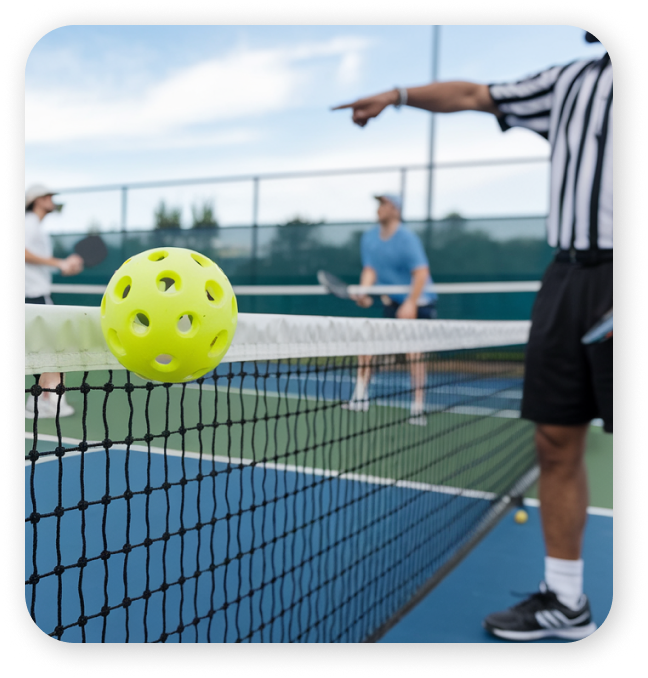
-
A ball in play that is stopped by a player before it becomes dead (e.g., catching or stopping a ball in flight before it hits the playing surface). The fault is on the player who stopped the ball.
-
After the serve, if the ball contacts any permanent object before bouncing on the court.
-
A player hitting the ball before it fully crosses the plane of the net.
-
A player carrying or catching the ball on the paddle during the serve or rally.
-
A hinder call by a player that the referee determines to be invalid.
-
In non-officiated matches, players may carry an additional pickleball as long as it is not visible to the opponent during play. If the additional ball falls onto the playing surface during play, a fault will be declared.
12. dead ball
- Any action that stops play results in a dead ball.
- A fault called by a referee or player, or a fault committed by a player, results in a dead ball.
- A hurdle called by the referee or player results in a dead ball. The referee will determine the validity of the hinder call by a player. A valid hinder, or a hinder called in non-officiated play, results in a replay.
- A ball in play that contacts a permanent object after bouncing on the opponent’s court results in a dead ball. The player who hit the ball wins the rally.
- Other than non-volley zone violations, a fault can only be committed when the ball is live. The penalty for a fault (excluding non-volley zone faults) is usually enforced when it is identified (e.g., distractions, double bounces) but can also be enforced anytime before the next serve occurs.
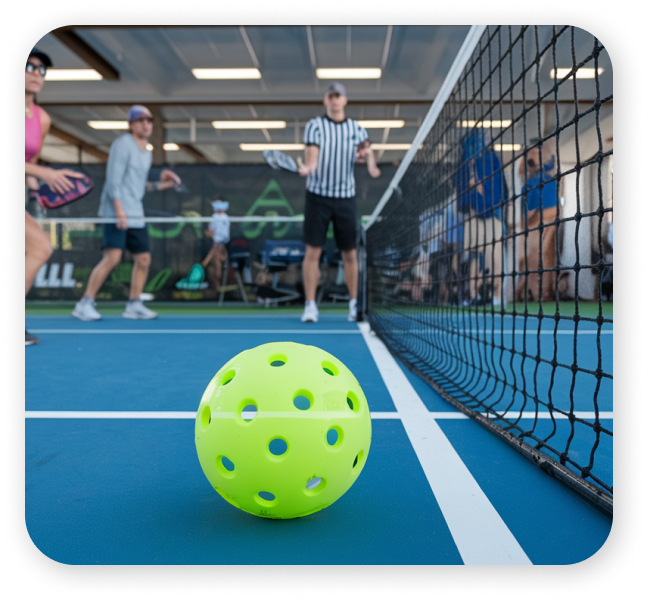
13. time-out rules

13.1 Standard Time-Out
A player or team is entitled to two time-outs in 11- or 15-point games and three time-outs in a 21-point game
-
Each time-out period may last up to 1 minute.
-
Play may resume early if all players are ready.
-
Any player on a team with remaining time-outs may call a time-out before the next serve occurs.
-
If a team calls a time-out while having no time-outs remaining, no penalty shall be called.
-
The referee will announce when there are 15 seconds remaining. At the end of the time-out period, the referee will call “time in” and then announce the score when all players are (or should be) ready to play.
13.2 Medical Time-Out
A player needing medical attention during a match should request a medical time-out from the referee. The following guidelines apply:
13.2.1 The referee shall immediately summon on-site medical personnel, or the Tournament Director if no medical personnel are present, to assess the situation and render appropriate first aid.
- When medical personnel or the Tournament Director arrive, the referee shall start the 15-minute time.
13.2.2 If medical personnel or the Tournament Director determine that a valid medical condition exists, the player will be allowed no more than 15 minutes for the medical time-out.
-
The time-out must be continuous and not exceed 15 minutes. Time spent transporting the player to and from an off-court location for medical treatment is excluded from the 15-minute period.
-
If the player uses fewer than 15 minutes, the remaining time is lost, and no additional medical time will be available during the match.
-
If the player cannot resume play after the 15-minute medical time-out, the match will be declared a retirement. The player may use any available regular time-outs after the medical time-out to allow more time before the match must be retired.
13.2.3 If no valid medical condition is determined, the player or team will be charged a standard time-out, if available, and issued a technical warning.
-
If a standard time-out is unavailable, a technical foul will be issued.
-
The medical time-out is no longer available to that player for that match.
-
A player may be granted only one player-requested medical time-out per match.
13.2.4 Presence of blood: If blood is present on a player or on the court, play may not resume until the bleeding is controlled and the blood on clothing and the court is removed.
- Issues solely related to blood cleanup or control will be considered a referee time-out.
13.3 Continuous Play
Play should be continuous, but players are permitted to take a quick drink or towel off between rallies as long as the flow of the game is not adversely impacted. The referee will call the score when play should resume.
13.4 Equipment Time-Outs
Players are expected to keep all apparel and equipment in good playable condition. If the referee determines that an equipment change or adjustment is necessary for the fair and safe continuation of the match, the referee may award an equipment time-out of reasonable duration. Rule 10.A.5 will be used to resume play. In non-officiated matches, players will work out a reasonable accommodation among themselves for equipment malfunctions.
13.5 Time Between Matches
The standard time between matches is 10 minutes. If all players are ready to play before 10 minutes, the match may start early.
- In a championship match with a tie-breaker match: If the winner of the loser’s bracket defeats the winner of the winner’s bracket, a tie-breaker match to 15 points must be played. The standard time between the championship match and the tie-breaker match is 10 minutes
13.6 Suspended Games
The standard time between matches is 10 minutes. If all players are ready to play before 10 minutes, the match may start early.
13.7 Other Time-Out Rules
Before a Match or Between Games: Neither medical nor regular time-outs may be taken before a match starts. A match cannot begin until all players are present and the starting score is called. Time-out(s) may be used before the start of the second and subsequent games in a multiple-game match.
13.8 Extenuating Circumstances
The referee may call a referee time-out to address extenuating circumstances that may require an extended interruption of play.
- In the interest of safety, if the referee determines a potential medical situation exists (e.g., heat exhaustion, heat stroke, etc.), and the player is unable or refuses to call a medical time-out, the referee is authorized to call a referee time-out and summon medical personnel or the Tournament Director. Referee-requested time-outs will not be charged against the player.
- Foreign substances on the court, such as debris, water, or other fluids, shall be removed or cleaned up.
14. other rules
14.1 Double Hits
- You can hit the ball twice, but it must be in one continuous motion and in one direction. If it’s not continuous or if another player hits the ball, it’s a fault.
14.2 Switching Hands
- You can switch the paddle between hands anytime.
14.3 Two-Handed Shots
- Using two hands to hit the ball is allowed.
14.4 Missed Shot
- If you completely miss the ball when trying to hit it, the ball is still in play until it bounces twice or another fault occurs.
14.5 Broken or Soft Ball
- If the ball is damaged during play, the rally continues until it ends. Afterward, you can check the ball and replace it if necessary. If the ball being damaged affected the rally, a replay might be called.
14.6 Injury During Rally
- If a player gets injured during a rally, the play continues until the rally ends.
14.7 Equipment Problems
- If you lose or break your paddle or something you’re wearing during a rally, the rally doesn’t stop unless it causes a fault.
14.8 Items on the Court
- If something a player is wearing or carrying falls on their side of the court, the ball stays in play unless it lands in the non-volley zone during a volley.
14.9 Plane of the Net
- You can’t cross the net before hitting the ball. After hitting the ball, you or anything you’re wearing can cross the net, but you can’t touch the net, your opponent’s court, or your opponent while the ball is in play.
-
14.9.1 Exception : You can’t cross the net before hitting the ball. After hitting the ball, you or anything you’re wearing can cross the net, but you can’t touch the net, your opponent’s court, or your opponent while the ball is in play.

14.10 Distractions
- You can’t intentionally distract your opponent when they’re about to hit the ball. If the referee thinks you did, it’s a fault.
14.11 Net Posts
- Net posts are out of bounds. It’s a fault if you touch them while the ball is live, or if the ball hits the post.
14.12 Net Rules
- 14.12.1 If the ball hits the top of the net and lands in, it’s still in play.
- 14.12.2 If the ball goes between the net and the post, it’s a fault.
- 14.12.3 You can go around the net post to hit the ball, but you can’t touch your opponent’s court.
- 14.12.4 If the ball bounces back over the net after you hit it, and your opponent doesn’t touch it, you win the rally.
- 14.12.5 Special rules apply if the ball hits parts of the net system like a horizontal bar or base, which could result in a replay or a fault.
14.13 Shots Around the Net Post
- You can hit the ball around the net post, even below the net height. The ball doesn’t have to go over the net.
14.14 One Paddle
- You can only use one paddle during a rally. Using more than one is a fault.
14.15 Paddle Possession
- You must be holding the paddle when you hit the ball. Not doing so is a fault.
14.16 Electronic Equipment
- You can’t wear headphones or earbuds during play, but hearing aids are allowed.
All rules are referenced from the USA Pickleball Official Rulebook.



